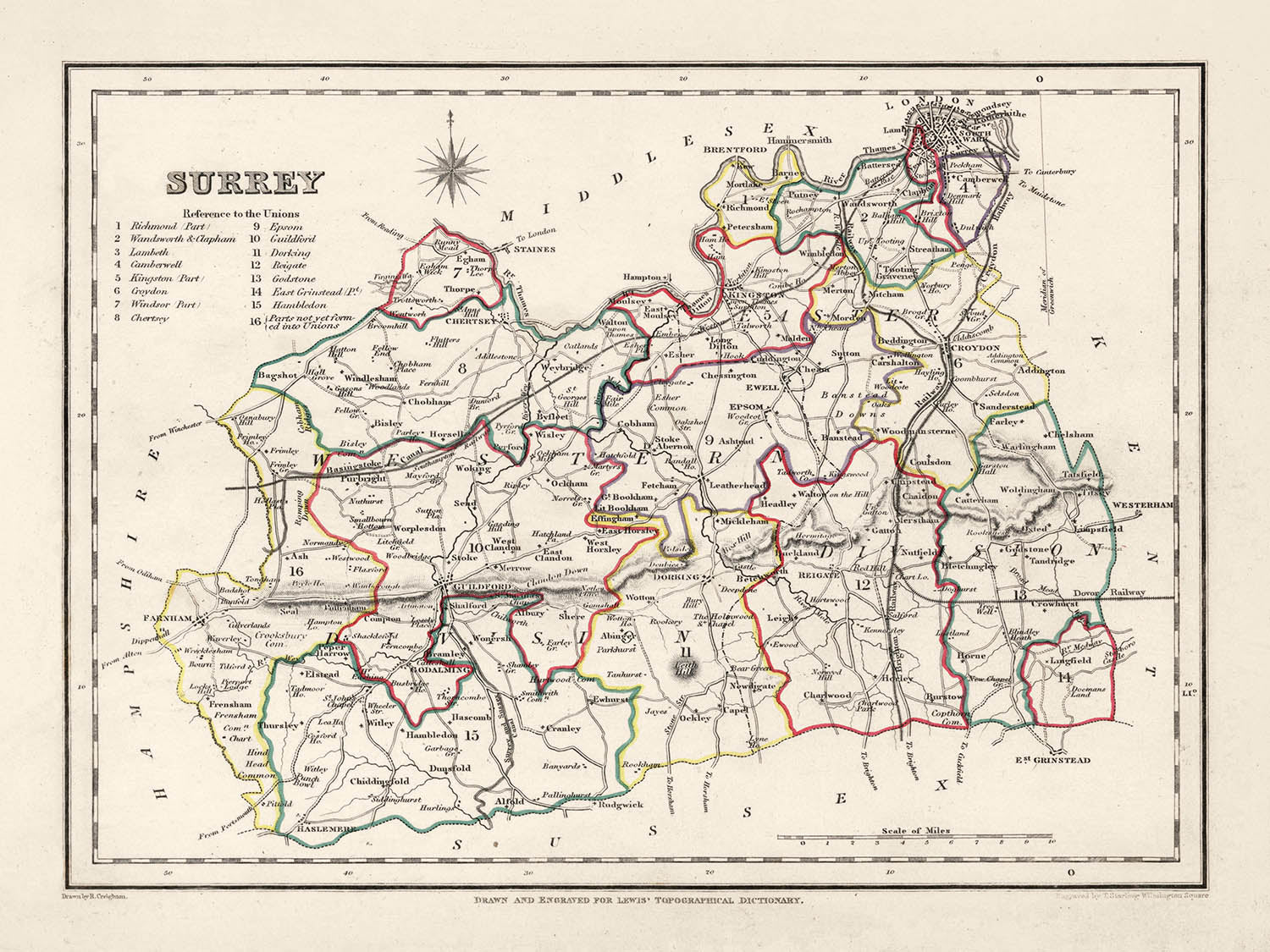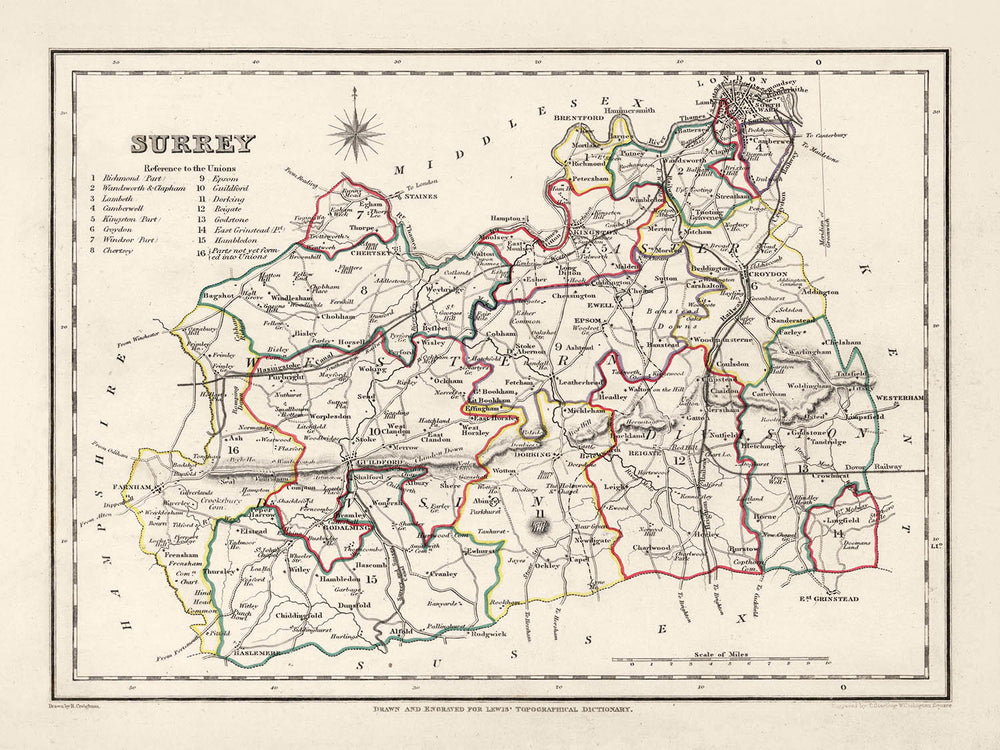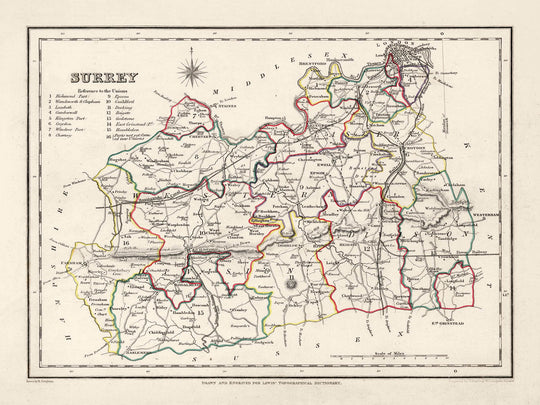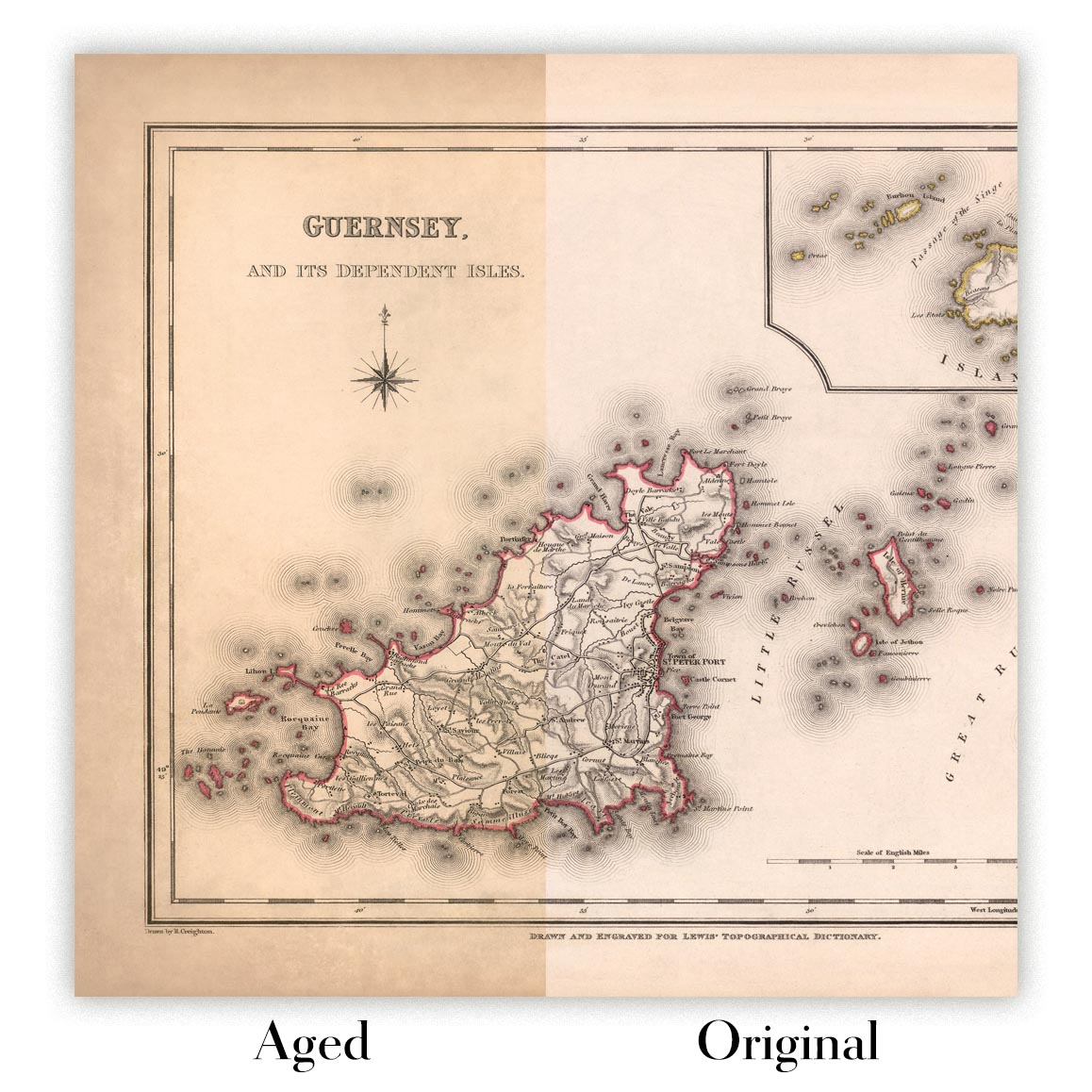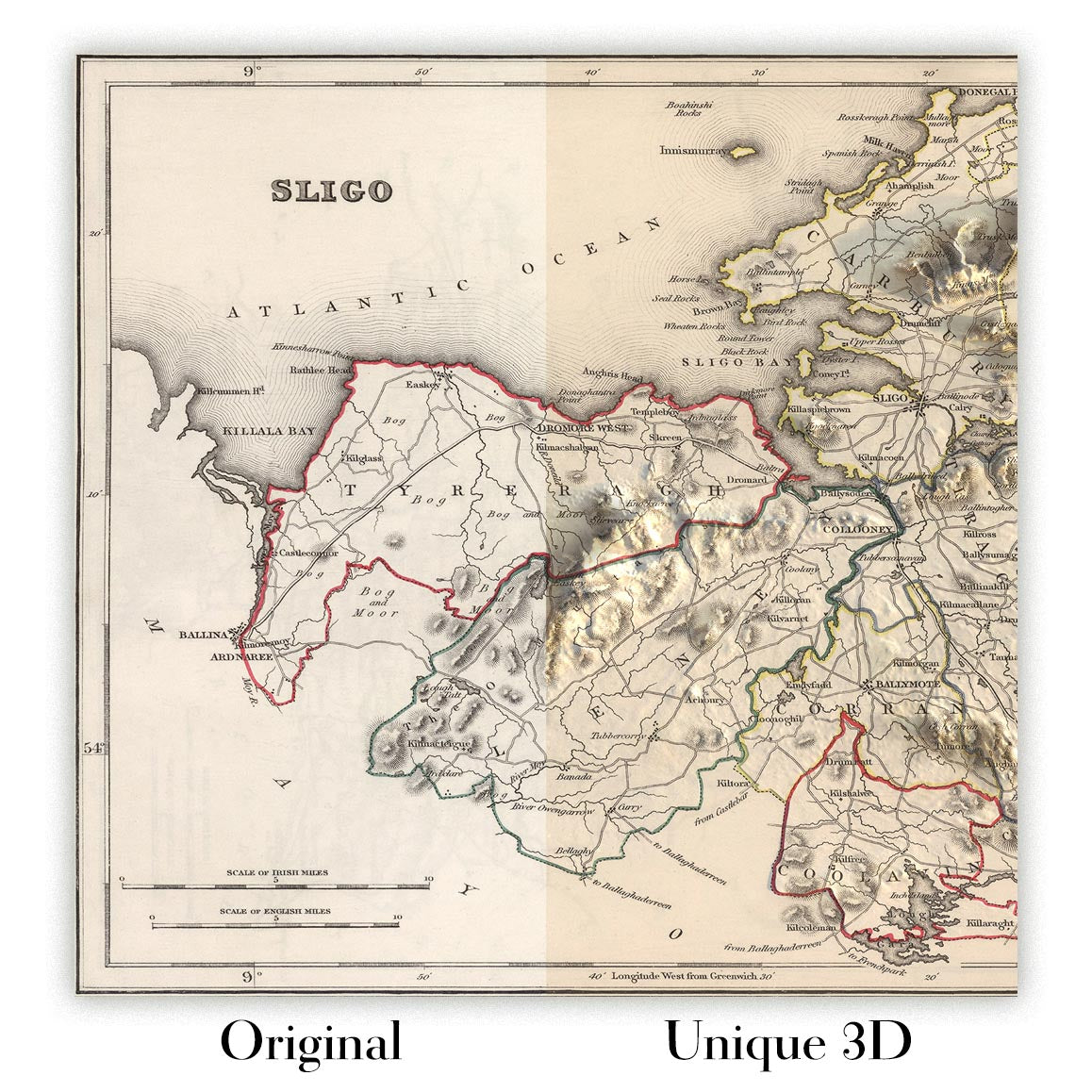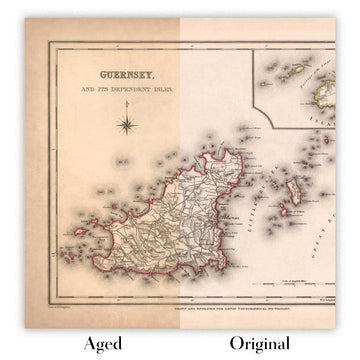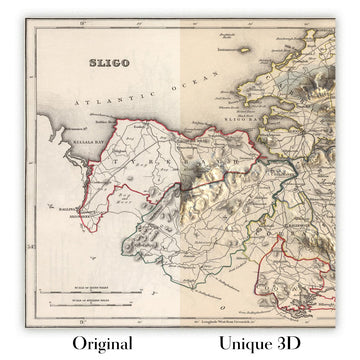- Handmade locally. No import duty or tax
- FREE Delivery by Christmas
- Love it or your money back (90 days)
- Questions? WhatsApp me any time
Own a piece of history
5,000+ 5 star reviews


Embrace a piece of historical cartography with this striking 1844 map of Surrey by Samuel Lewis. This visually captivating artwork is more than just a historical relic; it's a portal into the past, allowing us to trace the evolution of some of England's most beloved cities, towns, and settlements that were rooted in history even at the time of this map's creation.
Steeped in rich history, Surrey's past can be fascinatingly traced through its settlements. This 1844 map includes places that were thriving before 1840, some of which have transformed significantly or even changed names. Conversely, you might find an absence of some modern-day settlements that were yet to be founded or recognised. This creates an exciting opportunity for historical discovery and comparison.
Settlements
(in order of modern-day population size):- London (43 AD): Established by the Romans as Londinium, it was an important commercial town and the provincial capital.
- Guildford (c. 970 AD): Home to a Royal Mint from the reign of King Alfred until the time of William the Conqueror.
- Woking (c. 1086 AD): Noted in the Domesday Book as Wochinges, it was held by King William.
- Ewell (before 775 AD): Known for its Roman remains, including a villa and bath house.
- Camberley (c. 1200 AD): Historically part of an area known as Bagshot Heath, famed for highwaymen in the 17th century.
- Redhill (c. 1818 AD): Originally a staging post on the London to Brighton road during the 18th century.
- Reigate (c. 1088 AD): Home to Reigate Castle, believed to have been established shortly after the Norman Conquest.
- Staines-upon-Thames (c. 100 AD): A historic market town that was once the site of a Roman bridge.
- Sunbury-on-Thames (before 962 AD): Mentioned in the Anglo-Saxon Chronicle, known for its riverside location.
- Banstead (before 1086 AD): Known for its history in agriculture, mentioned in the Domesday Book.
- Epsom (before 1086 AD): The home of Epsom Salt and the Epsom Derby.
- Farnham (c. 688 AD): Known for its Georgian streetscape and an ancient deer park.
- Dorking (c. 1086 AD): Home to Dorking Halls, an important venue for concerts and films.
- Chertsey (c. 666 AD): Known for its Abbey, which was one of the largest Benedictine monasteries in England.
- Godalming (c. 880 AD): In 1881, it became the world's first town to have a public electricity supply.
- Haslemere (before 1221 AD): Known for its "Georgian and earlier" town center.
- Caterham (before 1086 AD): Mentioned in the Domesday Book and the home of the Caterham Cars manufacturer.
- Leatherhead (before 880 AD): A significant crossroads on the main route from London to the south coast.
- Esher (before 1086 AD): Home to Claremont Landscape Garden, a noted National Trust property.
- Cobham (before 1086 AD): Known for its historic buildings including Cobham Mill, an 1822 watermill.
- Walton-on-Thames (before 1086 AD): Site of a Roman fort, the "Statio Albani," on the military road to London.
- East Molesey (before 1086 AD): Home to Hampton Court Palace, built for Cardinal Thomas Wolsey in the early 16th century.
- Ashtead (before 1086 AD): Known for its Roman villa and tileworks excavated in the 1920s and 1980s.
- Horley (before 1086 AD): Located near Gatwick Airport, one of the major international airports near London.
- Oxted (c. 1086 AD): Home to a 16th-century timber-framed house known as Titsey Place.
- Frimley (before 1086 AD): Known for Frimley Park Hospital, serving as a major regional healthcare facility.
- Hersham (before 1086 AD): Home to Burhill Golf Club, located on a part of the old Manor estate.
- Addlestone (c. 1241 AD): Known for the Crouch Oak, an ancient tree believed to date back to the 11th century.
- Shepperton (before 1086 AD): Known for Shepperton Studios, one of the major film studios in the UK.
- Warlingham (before 1086 AD): Known for its green-belt land in the Surrey Hills.
Notable Features:
- The River Thames, a major waterway in England, notable for its role in trade, transportation, and recreation.
- The North Downs, a ridge of chalk hills, part of an Area of Outstanding Natural Beauty (AONB).
- Box Hill, a popular tourist attraction with panoramic views and rare wildlife.
- Virginia Water Lake, located in Windsor Great Park, popular for its beautiful landscapes.
Historical Events (1800-1850):
- The building of the London to Southampton Railway (1838), which led to the rapid growth of towns like Woking.
- The inaugural running of the Epsom Derby, a prestigious horse race, in 1780 (with its continuous run well into the studied period).
Discover, explore, and fall in love with the enchanting history of Surrey through this remarkable 1844 map by Samuel Lewis. A perfect blend of history, art, and culture, it is truly an excellent addition to any collection or a great gift for the passionate history lover.
Please double check the images to make sure that a specific town or place is shown on this map. You can also get in touch and ask us to check the map for you.
This map looks great at all sizes: 8x10in (20.5x25.5cm), 12x16in (30.5x41cm), 18x24in (45.5x61cm), 16x20in (40.5x51cm), 24x36in (61x91.5cm), 30x40in (76x101.5cm) and 37x50in (94x127cm), but it looks even better when printed large.
I can create beautiful, large prints of this map up to 50in (127cm). Please get in touch if you're looking for larger, customised or different framing options.
The model in the listing images is holding the 18x24in (45.5x61cm) version of this map.
The fifth listing image shows an example of my map personalisation service.
If you’re looking for something slightly different, check out my main collection of UK and Ireland maps.
Please contact me to check if a certain location, landmark or feature is shown on this map.
This would make a wonderful birthday, Christmas, Father's Day, work leaving, anniversary or housewarming gift for someone from the areas covered by this map.
This map is available as a giclée print on acid free archival matte paper, or you can buy it framed. The frame is a nice, simple black frame that suits most aesthetics. Please get in touch if you'd like a different frame colour or material. My frames are glazed with super-clear museum-grade acrylic (perspex/acrylite), which is significantly less reflective than glass, safer, and will always arrive in perfect condition.
This map is also available as a float framed canvas, sometimes known as a shadow gap framed canvas or canvas floater. The map is printed on artist's cotton canvas and then stretched over a handmade box frame. We then "float" the canvas inside a wooden frame, which is available in a range of colours (black, dark brown, oak, antique gold and white). This is a wonderful way to present a map without glazing in front. See some examples of float framed canvas maps and explore the differences between my different finishes.
For something truly unique, this map is also available in "Unique 3D", our trademarked process that dramatically transforms the map so that it has a wonderful sense of depth. We combine the original map with detailed topography and elevation data, so that mountains and the terrain really "pop". For more info and examples of 3D maps, check my Unique 3D page.
For most orders, delivery time is about 3 working days. Personalised and customised products take longer, as I have to do the personalisation and send it to you for approval, which usually takes 1 or 2 days.
Please note that very large framed orders usually take longer to make and deliver.
If you need your order to arrive by a certain date, please contact me before you order so that we can find the best way of making sure you get your order in time.
I print and frame maps and artwork in 23 countries around the world. This means your order will be made locally, which cuts down on delivery time and ensures that it won't be damaged during delivery. You'll never pay customs or import duty, and we'll put less CO2 into the air.
All of my maps and art prints are well packaged and sent in a rugged tube if unframed, or surrounded by foam if framed.
I try to send out all orders within 1 or 2 days of receiving your order, though some products (like face masks, mugs and tote bags) can take longer to make.
If you select Express Delivery at checkout your order we will prioritise your order and send it out by 1-day courier (Fedex, DHL, UPS, Parcelforce).
Next Day delivery is also available in some countries (US, UK, Singapore, UAE) but please try to order early in the day so that we can get it sent out on time.
My standard frame is a gallery style black ash hardwood frame. It is simple and quite modern looking. My standard frame is around 20mm (0.8in) wide.
I use super-clear acrylic (perspex/acrylite) for the frame glass. It's lighter and safer than glass - and it looks better, as the reflectivity is lower.
Six standard frame colours are available for free (black, dark brown, dark grey, oak, white and antique gold). Custom framing and mounting/matting is available if you're looking for something else.
Most maps, art and illustrations are also available as a framed canvas. We use matte (not shiny) cotton canvas, stretch it over a sustainably sourced box wood frame, and then 'float' the piece within a wood frame. The end result is quite beautiful, and there's no glazing to get in the way.
All frames are provided "ready to hang", with either a string or brackets on the back. Very large frames will have heavy duty hanging plates and/or a mounting baton. If you have any questions, please get in touch.
See some examples of my framed maps and framed canvas maps.
Alternatively, I can also supply old maps and artwork on canvas, foam board, cotton rag and other materials.
If you want to frame your map or artwork yourself, please read my size guide first.
My maps are extremely high quality reproductions of original maps.
I source original, rare maps from libraries, auction houses and private collections around the world, restore them at my London workshop, and then use specialist giclée inks and printers to create beautiful maps that look even better than the original.
My maps are printed on acid-free archival matte (not glossy) paper that feels very high quality and almost like card. In technical terms the paper weight/thickness is 10mil/200gsm. It's perfect for framing.
I print with Epson ultrachrome giclée UV fade resistant pigment inks - some of the best inks you can find.
I can also make maps on canvas, cotton rag and other exotic materials.
Learn more about The Unique Maps Co.
Map personalisation
If you're looking for the perfect anniversary or housewarming gift, I can personalise your map to make it truly unique. For example, I can add a short message, or highlight an important location, or add your family's coat of arms.
The options are almost infinite. Please see my map personalisation page for some wonderful examples of what's possible.
To order a personalised map, select "personalise your map" before adding it to your basket.
Get in touch if you're looking for more complex customisations and personalisations.
Map ageing
I have been asked hundreds of times over the years by customers if they could buy a map that looks even older.
Well, now you can, by selecting Aged before you add a map to your basket.
All the product photos you see on this page show the map in its Original form. This is what the map looks like today.
If you select Aged, I will age your map by hand, using a special and unique process developed through years of studying old maps, talking to researchers to understand the chemistry of aging paper, and of course... lots of practice!
If you're unsure, stick to the Original colour of the map. If you want something a bit darker and older looking, go for Aged.
If you are not happy with your order for any reason, contact me and I'll get it fixed ASAP, free of charge. Please see my returns and refund policy for more information.
I am very confident you will like your restored map or art print. I have been doing this since 1984. I'm a 5-star Etsy seller. I have sold tens of thousands of maps and art prints and have over 5,000 real 5-star reviews. My work has been featured in interior design magazines, on the BBC, and on the walls of dozens of 5-star hotels.
I use a unique process to restore maps and artwork that is massively time consuming and labour intensive. Hunting down the original maps and illustrations can take months. I use state of the art and eye-wateringly expensive technology to scan and restore them. As a result, I guarantee my maps and art prints are a cut above the rest. I stand by my products and will always make sure you're 100% happy with what you receive.
Almost all of my maps and art prints look amazing at large sizes (200cm, 6.5ft+) and I can frame and deliver them to you as well, via special oversized courier. Contact me to discuss your specific needs.
Or try searching for something!







